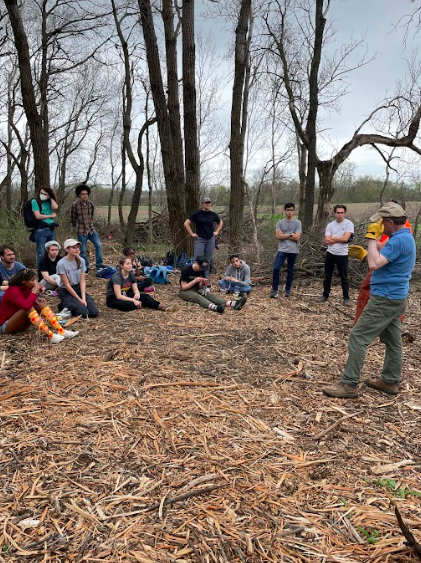ARCN 246, “Archaeological Methods and Lab,” is a relatively new addition to Carleton’s archaeology concentration. It is a required course for the minor that, according to the course catalog, “provides a hands-on introduction to the entire archaeological process through classroom, field, and laboratory components.” For its first “four or five” times being taught, Dr. Sarah Kennedy explains, “[we’ve] mainly focused on doing archaeology in the Arb and [our] field trips were just to local historic museums.” This Spring Term, however, the class’s focus broadened. To be precise: It broadened by roughly 100 miles, which is the distance between campus and the class’s recent field trip destination — the Grand Meadow Chert Quarry. A far cry from the usual Arb excavations, the Chert Quarry trip was not only a historical learning opportunity but also a chance to perform community service and understand archaeology’s true scope.
Located near the town of Grand Meadow, the Grand Meadow Chert Quarry is a 170-acre-wide heavily forested area. Despite being on farmland, it “hasn’t been farmed recently [or] probably ever,” a sophomore taking the class says. It has not been the site of human activity since “around 400 years ago,” when it was abandoned.
The quarry’s significance today lies in its historical importance to Indigenous craftsmanship. Its soil contains rich, high-quality deposits of chert, a grayish sedimentary rock ideal for stone tools such as arrowheads. For over 8,000 years, the sophomore explains, Native Americans would “make pilgrimages” to the quarry when their tools became worn-out. Archaeological evidence suggests that Native Americans extracted the chert before smashing it into smooth, glassy shards with boulders strewn around the area. Since chert is “not found in very many places,” researchers have “traced stone tools from around Minnesota” back to the Grand Meadow Chert Quarry, the sophomore says.
However, Kennedy’s class was not at the quarry to dig for evidence. As an Academic Civic Engagement (ACE) course, ARCN 246 includes a community service component, which the students fulfilled by helping refurbish the area. According to Brian Best ’24, “We… clean[ed] up a site by removing buckthorn and other plants that would make the pathways difficult to navigate” ahead of a public opening scheduled for 2023. Kennedy reported seeing “a lot of shock on the students’ faces” at first, but they soon settled into the work: “It reminded me a bit of when I used to remove greenery from an old cemetery in my hometown,” Best recalls. The anonymous sophomore added, “When you combine the ability of 20 people, it’s really easy to get a shocking amount [done]… the labor felt valuable in a way that working in the Arb doesn’t.”
Uprooting plants is not normally the sort of excavation one associates with archaeology. However, Kennedy informs us that diplomacy and site maintenance are integral to the discipline as it is currently practiced. The Prairie Island Indian Community, which has ties to several Carleton faculty, considers Grand Meadow a part of its homeland. “We really want to strengthen that relationship with students,” Kennedy says, “because a lot of the issues that [American] archaeologists grapple with today have to do with… the ethical ramifications of… uncovering largely Native American remains.” Cleaning the quarry, then, is “the legwork of building the relationship… a way to show them that we’re interested in the site,” she says.
The guest speakers, Prairie Island Indian Community archaeologist Tom Trow and tribal liaison Franky Jackson, addressed some of the dilemmas inherent in conducting fieldwork on Indigenous land. As someone with a deep connection to the land, Jackson has long been in the habit of making a tobacco offering to every dig site he visits to offset the archaeologists’ removals — yet federal law prohibits placing anything in the soil that was not there before, underscoring the disconnect between governments and Indigenous communities. Trow explicitly told the students not to pick up any stone tools they might find, cognizant of past archaeologists’ tendency to pilfer artifacts and remove valuable context. “If an object is found near an animal skull,” Kennedy explains, “you might say, ‘oh, they were using that tool to that animal.’ If it’s found near a human skull, you might say ‘oh, they were buried with that item and it has some sort of symbolic importance.’” However, if someone were to pocket a tool and take it back to Northfield, future archaeologists might conclude that “maybe people in Northfield were using Grand Meadows chert,” which “removes the context.”
Kennedy and the archaeology department hope to build their relationship with the Prairie Island Indian Community moving forward. Chair Alex Knodell, in particular, is interested in developing a field school at the Grand Meadows Chert Quarry for student summer excavations. As the department works toward that long-term goal, Kennedy’s short-term goal of “gain[ing] a deeper appreciation of Indigenous histories at Carleton” seems a step closer to fulfillment after the field trip. “It’s very interesting to understand how… the conservation efforts of Indigenous communities are playing out in the modern day,” Best says. “I felt as though the work I was doing would enable future visitors to [better understand] their ancestors’ past relationships with the land,” the anonymous sophomore concluded. “As you uncover things, as you beautify, as you build trails, et cetera, [a site] sort of becomes this thing that people visit and work from.”












